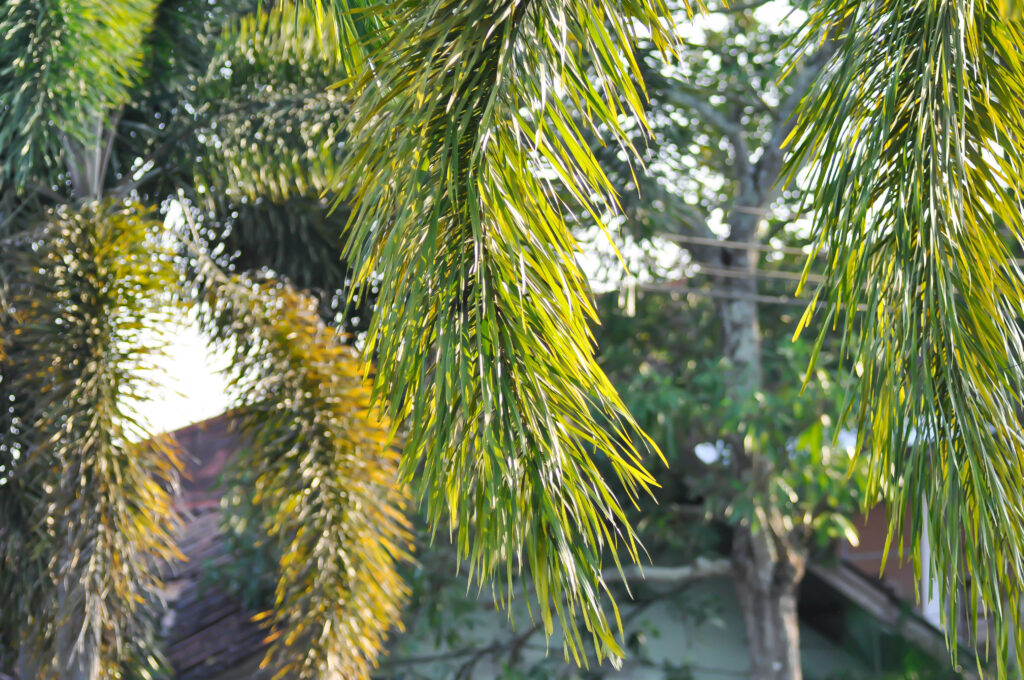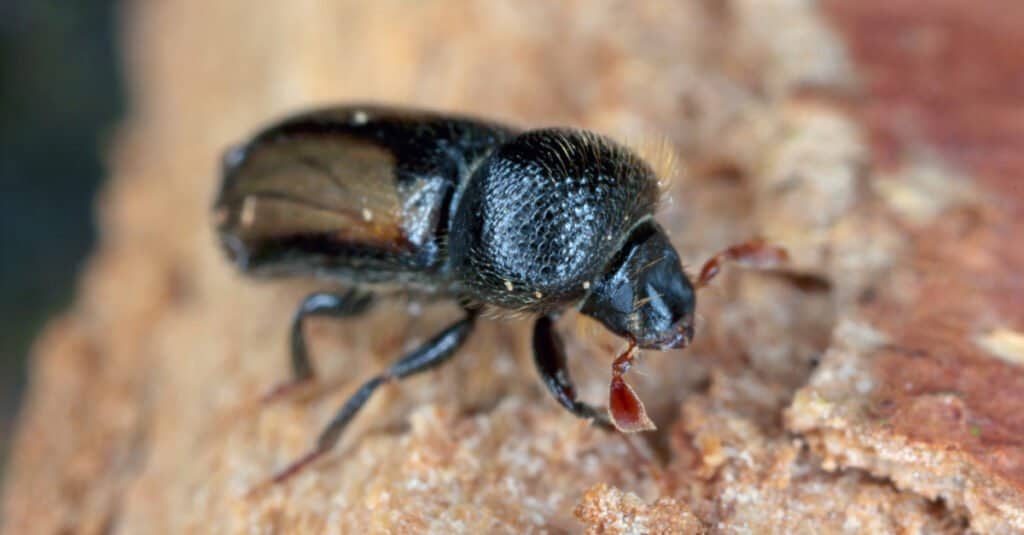Among all the palm trees out there, the foxtail palm tree boasts the most amazing leaf displays. Its fronds grow in a curved fashion, not unlike that of a fox’s bushy tail. Due to its extreme toughness and ability to thrive in a broad range of soil types, including rocky sands and alkaline limestone soils, the foxtail palm has become more popular in landscaping around the world. It can easily endure drought and strong winds thanks to its extensive root system. As a potted plant, the foxtail palm can also be grown and thrive indoors.
In this guide, we’ll take a look at some interesting facts about the foxtail palm tree, as well as how to grow one at home.
What is the Foxtail Palm Tree?
The foxtail palm tree is classified as Wodyetia bifurcata, is a member of the Arecaceae plant family, and is the only species in the Wodyetia genus of plants. It is native to Australia. It is a tall evergreen palm tree with eight to nine-foot-long plumose leaves. The palm itself can reach up to 33 feet. This species produces orange fruit and white flowers that grow from the bottom of the palm’s crownshaft.
The foxtail palm’s smooth, slender, and self-cleaning trunk is comparable to that of the king palm. It can reach heights of around 33 feet with a single, double, or triple trunk that ranges from somewhat spindle-shaped to columnar. Moreover, the trunk has a densely ringed, dark to light gray tint that gradually becomes more and more white. The foxtail palm tree’s crownshaft is light to vibrant green in color and has a somewhat swelled base. From deep green to light green, the leaves of this plant offer a variety of greenish hues.
The foxtail palm is an endangered species that can only be found in a very restricted area in Australia. It was first discovered in the rocky gravel hills of Cape Melville, which is entirely contained within the Cape Melville National Park. The region is known for its great biocultural variety, long-standing close ties to the Aboriginal population, and abundant wildlife. This species is a moderate to speedy grower and can live for as long as 25 years in ideal conditions. It can only grow in USDA hardiness zone 10.

Foxtail palm tree fronds (pictured) look similar to a fox’s tail, hence its name.
©iStock.com/Jobrestful
How to Plant and Grow a Foxtail Palm Tree
Although it is an Australian native plant, the foxtail palm thrives in tropical climates with mild winters, such as Florida. This has led to this palm being a standard choice for tropical landscaping. You can enjoy a good-sized tree in a few years thanks to its rapid growth.
These palms are a wonderful option for coastal settings since they can tolerate some salt. Foxtail palms can be challenging to cultivate indoors since they need lots of light, unless you have a conservatory or greenhouse. If you can keep them alive and provide them with enough light, though, they make lovely indoor potted specimens.
Although the foxtail palm is usually planted alone, groups of three or more look the best when it comes to landscaping. When this species is planted in gardens full of lush and vibrant tropical plants, you can give your outdoor space the appearance of a tropical oasis and make it the ideal location for a garden seat or arbor.
Plant your foxtail palms at least eight feet away from a house or other building since their leaves are quite enormous and will fall off the trees when they die. If you’re planting a row of foxtail palms, space them at least six to seven feet apart.
Add organic peat humus or topsoil to your planting hole before transplanting your young foxtail palm. Foxtail palms consume a lot of plant food. Use a micronutrient-rich granular fertilizer to nourish your palm trees. Do this in spring, summer, and autumn. To keep up the fronds’ most attractive deep-green hue, supplement feedings by occasionally administering manganese or magnesium to the soil.
These palms produce blooms and seeds just like all other plants do. A better-developed foxtail palm will yield a huge, heavy cluster of fruit with seeds after flowering. Each fruit is the size of a roma tomato and is a beautiful and brilliant crimson. Bear in mind that this species is probably never going to produce fruit if you opt to grow it in a pot indoors.
The foxtail palm is useful in a variety of landscape settings. It can be cultivated in yards, as the centerpiece of a garden, in the middle of a roundabout, or in a row along sidewalks and roadways. They can also be grown outdoors in pots or pool containers.

Foxtail palms tend to only produce fruit (pictured) when planted outdoors.
©iStock.com/Kanur Ismail
How to Care for a Foxtail Palm Tree
Foxtail palm trees require little maintenance since they can shed, meaning dead leaves will fall off on their own. With the proper weather, light, and soil, they should require little in the way of ongoing maintenance. Both indoor and outdoor foxtail palms can be taken care of according to the following guidelines.
Foxtail palms need at least six hours of direct sunlight each day to thrive, so plant them or place them where they will receive full sun. They can withstand some shade, but they don’t develop as rapidly as plants in full sunlight, and they are more vulnerable to fungal infections if kept in shady areas.
Foxtail palms prefer sandy, well-drained soil that is just a little bit acidic. They are not suitable for areas that have prolonged standing water. Instead, grow them in elevated mounds in clay-rich areas, or in pots with adequate draining holes. These trees don’t often need irrigation to live after they are established since they are drought-tolerant. But, if extra water is provided to them during a drought, they will grow a bit faster. Water new plants whenever their soil becomes dry to the touch for one to two years. After they’re established, depending on how dry the soil gets, water once a week or more.
The foxtail palm prefers USDA hardiness zone 10 and grows especially well in sunny southern Florida since it needs warm temperatures and lots of humidity. For this species to remain healthy, temperatures need to stay consistently above 60 degrees F.
Using a fertilizer made specifically for palms in the spring can keep the fronds looking rich and dark green. For application rates, adhere to the instructions on the product label for the fertilizer you choose to purchase. Upon planting, cover the soil with a four-inch layer of mulch to reduce weed competition and guard against damage from lawnmowers or animals.
Wait to repot your foxtail palm until it is extremely necessary since it might be detrimental to its health. Before transplanting, keep the roots extra wet for a few days. Move the soil and roots from the original pot and place them in a new one that is big enough for fresh growth but not so big that standing water can become an issue. For the first several days after transplanting, keep your palm out of direct sunlight to give the roots time to establish.
How to Propagate a Foxtail Palm Tree
Foxtail palm trees can grow and propagate from seeds. In a six to 12-inch container, plant a few foxtail seeds in aerated, sandy soil. Palm seeds can be purchased from your local nursery or only via specialty stores. When planting, ensure that the seeds are separated and not touching each other. Place the pot on a heat mat set to 90 to 95 degrees F and cover it with a plastic dome or bag to trap humidity to help with germination. It takes around four to six months for foxtail seeds to completely germinate, so be patient! Your foxtail seeds are ready to be replanted into a bigger pot once they have sprouted and are about three inches tall.
Pests and Diseases to Watch Out For
Root rot or crown rot, which is indicated by browning or yellowing fronds, can harm foxtail palms and even cause death. Poor drainage or overwatering, which causes the roots to become mushy, is the primary cause of both of these issues. Use caution when watering foxtail palms and try to stick to a watering schedule.
Brown spot and leaf blight are additional problems that foxtail palms might face both as outdoor plants and houseplants. A good fungicide can be used to treat either disease. Foxtail palm trees can become deficient in iron or potassium, which can be treated with fertilizer. These issues can be detected by looking for brown or decaying leaves. These trees are also susceptible to infestation by mealybugs, banana moths, and ambrosia beetles, among other insects. Treat your indoor palm with an organic pesticide to remove these pests. Outdoor plants tend to resolve pest infestations on their own, especially if they are older, well-established palms.
The leaves on this palm tree naturally become yellow and drop off. It’s a perfectly normal process. However, persistently yellowing fronds might be a symptom of a mineral deficit. Give your foxtail palm a good dose of fertilizer if you believe it is nutrient deficient.

Ambrosia beetles (pictured) tend to only affect outdoor foxtail palms rather than indoor plants.
©Tomasz Klejdysz/Shutterstock.com
Do Foxtail Palm Trees Need to Be Pruned?
Foxtail palm trees are excellent at shedding dead fronds on their own. It is not recommended to prune them, especially if they are very tall, so doing so can be dangerous and risky. They’re pretty good at taking care of themselves. However, if you have an indoor potted foxtail palm tree, you can remove extremely brown or dead leaves with clean scissors if needed for aesthetics.
Are Foxtail Palm Trees Toxic?
While there are different accounts regarding whether the foxtail palm is hazardous to people or animals, it is best to be cautious and prevent little children from putting leaves or other parts of the tree in their mouths as well as pets from ingesting any of the tree’s parts. Play it safe! There is some evidence online that the fruit, leaves, and seeds of the foxtail palm are poisonous to animals and should never be consumed since they might be lethal. Contact your vet immediately if you think your pet has munched on any part of your foxtail palm.
If you are a lover of palms and want to add something unique to your collection, the foxtail palm is an excellent choice. With the right amount of care, this species will last a quarter of a century. Just make sure you live in the right hardiness zone for this species if you plan to grow one outdoors.
The photo featured at the top of this post is © Supanee Prajunthong/Shutterstock.com
Thank you for reading! Have some feedback for us? Contact the AZ Animals editorial team.







